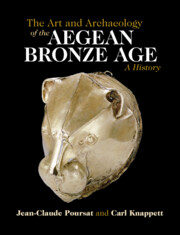Book contents
- The Art and Archaeology of the Aegean Bronze Age
- The Art and Archaeology of the Aegean Bronze Age
- Copyright page
- Contents
- Figures
- Introduction
- Part I Aegean Neolithic Art
- Part II The Art of the Aegean Early Bronze Age
- Chapter 6 Artefacts and Contexts
- Chapter 7 Architecture
- Chapter 8 Early Bronze Age Aegean Glyptic
- Chapter 9 Sculpture
- Chapter 10 Stone Vases, Metalware, and Miscellaneous
- Chapter 11 Early Bronze Age Pottery in the Aegean
- Part III Aegean Art in the Cretan First Palace Period
- Part IV Aegean Art in the Second Palace Period
- Part V Aegean Art in the Cretan Second Palace Period
- Part VI Aegean Art in the Final Palatial Period of Knossos
- Part VII Aegean Art of the Mainland Mycenaean Palatial Period
- Part VIII Aegean Art at the End of the Bronze Age
- Afterword Aegean Art Through Forgers’ Eyes
- References
- Index
- Plate Section (PDF Only)
- References
Chapter 11 - Early Bronze Age Pottery in the Aegean
from Part II - The Art of the Aegean Early Bronze Age
Published online by Cambridge University Press: 19 May 2022
- The Art and Archaeology of the Aegean Bronze Age
- The Art and Archaeology of the Aegean Bronze Age
- Copyright page
- Contents
- Figures
- Introduction
- Part I Aegean Neolithic Art
- Part II The Art of the Aegean Early Bronze Age
- Chapter 6 Artefacts and Contexts
- Chapter 7 Architecture
- Chapter 8 Early Bronze Age Aegean Glyptic
- Chapter 9 Sculpture
- Chapter 10 Stone Vases, Metalware, and Miscellaneous
- Chapter 11 Early Bronze Age Pottery in the Aegean
- Part III Aegean Art in the Cretan First Palace Period
- Part IV Aegean Art in the Second Palace Period
- Part V Aegean Art in the Cretan Second Palace Period
- Part VI Aegean Art in the Final Palatial Period of Knossos
- Part VII Aegean Art of the Mainland Mycenaean Palatial Period
- Part VIII Aegean Art at the End of the Bronze Age
- Afterword Aegean Art Through Forgers’ Eyes
- References
- Index
- Plate Section (PDF Only)
- References
Summary
At the start of the Early Bronze Age (EBA) we see a lot of continuity with an earlier tradition of incised decoration on closed vessels such as cylindrical pyxides (globular or biconical), small jars with narrow necks (footed or footless), and kandylia. Such vases usually have lateral lugs, allowing for their suspension and attaching lids (Figure 11.1). An EC I globular pyxis from Naxos (AE1, fig. 97) whose shape, like some stone vases, mimics a sea urchin is completely covered in diagonal incised lines arranged in alternating bands (herringbone). This motif, which is very common in the EBA, could have been in imitation of basketry or textiles (Rambach 2000, vol. II, 175–80). The incisions are often infilled with white paste, producing a contrast with the burnished black or reddish vase surface.
- Type
- Chapter
- Information
- The Art and Archaeology of the Aegean Bronze AgeA History, pp. 66 - 80Publisher: Cambridge University PressPrint publication year: 2022

